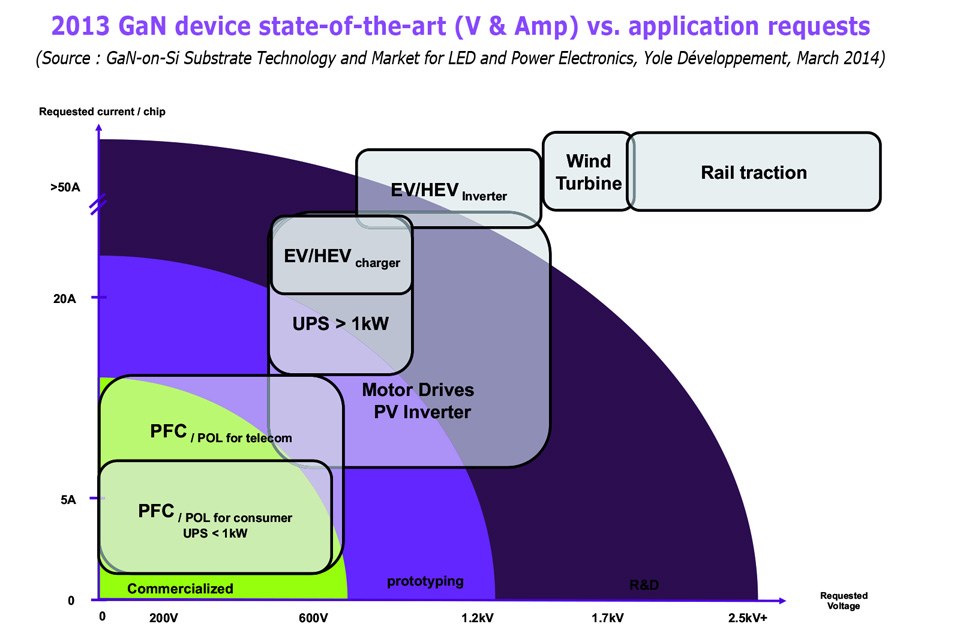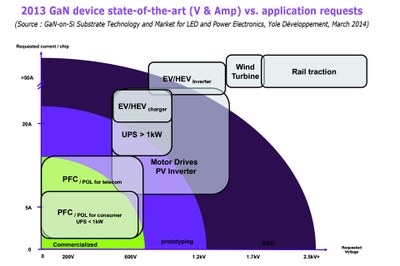Yole Développement's GaN-on-Si Report Forecasts Future of power Electronics and LEDs
Yole Développement releases this week the GaN-on-Si Substrate Technology and Market for LED and Power Electronics report. Under this report, Yole Développement reviews the GaN-on-Si technology growth, challenges and solutions. Dr Hong Lin and Dr Eric Virey, Yole Développement’s analysts give an overview of GaN-on-Si epiwafer playground. This report also provides an in-depth analysis of the GaN-on-Si technology for LED and power electronic applications, including technology and cost aspect. Yole Développement’s analysts, both develop possible business models for the adoption of GaN-on-Si technology. GaN-on-Si substrate technology and market for LED and Power Electronics report also includes market volume and revenue forecast to 2020.
GaN-on-Si LED is already adopted by some LED manufacturers, but could it become the industry standard?
Today, GaN on Sapphire is the main stream technology for LED manufacturing. GaN-on-Si technology appeared naturally as an alternative to sapphire to reduce cost. Yole Développement’s cost simulation indicates that the differential in silicon substrate cost is not enough to justify the transition to GaN-on-Si technology. The main driver is the ability to manufacture in existing, depreciated CMOS fabs in 6” or 8”.
“Despite potential cost benefits for LEDs, the mass adoption of GaN-on-Si technology for LED applications remains unclear. Opinions regarding the chance of success for LED-on-Si vary widely in the LED industry from unconditional enthusiasm to unjustified skepticism. Virtually all major LED makers are researching GaN-on-Si LED, but few have made it the core of their strategy and technology roadmap. Among the proponents, only Lattice Power, Plessey and Toshiba have moved to production and are offering commercial LED-on-Si”, explains Dr Hong Lin.
At Yole Développement, analysts believe that although significant improvements have been achieved, there are still some technology hurdles (performance, yields, CMOS compatibility). They consider that if the technology hurdles are cleared, GaN-on-Si LEDs will be adopted by some LED manufacturers, but will not become the industry standard. Yole Développement expects that Silicon will capture less than 5% of LED manufacturing by 2020.
GaN-on-Si technology will be widely adopted by power electronics applications
The power electronics market addresses applications such as AC to DC or DC to AC conversion, which is always associated with substantial energy losses that increase with higher power and operating frequencies. Incumbent silicon based technology is reaching its limit and it is difficult to meet higher requirements. GaN based power electronics have the potential to significantly improve efficiency at both high power and frequencies while reducing device complexity and weight. Power GaN are therefore emerging as a substitution to the silicon based technology. Today, Power GaN remains at its early stage and presents only a tiny part of power electronics market.
“We are quite optimistic about the adoption of GaN-on-Si technology for Power GaN devices. GaN-on-Si technology have brought to market the first GaN devices. Contrary to the LED industry, where GaN-on-Sapphire technology is main stream and presents a challenging target, GaN-on-Si will dominate the GaN based power electronics market because of its lower cost and CMOS compatibility”, says Dr Eric Virey. Although GaN based devices remain more expensive than Si based devices today, the overall cost of GaN devices for some applications are expected to be lower than Si devices three years from now, according to some manufacturers.
“In our nominal case, GaN based devices could reach more than 7% of the overall power device market by 2020”, adds Eric. GaN-on-Si wafers will capture more than 1.5% of the overall power substrate volume, representing more than 50% of the overall GaN-on-Si wafer volume, subjecting to the hypothesis that the 600V devices would take off in 2014-2015.
GaN-on-Si epiwafer: buy it or make it? Which business will be dominated?
To adopt the GaN-on-Si technology, device makers have the choice between buying epiwafers or templates on the open market, or buying MOCVD reactors and making epiwafer by themselves. Today, there is a limited number of players selling either epiwafers or templates or both on the open market. These players comes from Japan, US and Europe. We have not observed an absolute dominance from one region.
As perceived by device markers, each business model has its pros & cons in terms of IP, technology dependence, R&D investments, and time. According to Yole Développement’s reports, analysts do not expect to see a significant template/epiwafer business emerge for LEDs and consider that LEDs makers would prefer making their epiwafers internally for mass production. For the power electronics industry, the opinion is divided. Yole Dévelopement considers that buying epiwafers could work as long as the price of the epiwafer on the open market keeps decreasing.
About GaN-on-Si Substrate Technology and Market for LED report:
• Authors:
Dr. Hong Lin works at Yole Développement as a technology and market analyst since 2013. She is specialized in compound semiconductors and provides technical and economic analysis. Before joining Yole Développement, she worked as R&D engineer at Newstep Technologies. She was in charge of the development of cold cathodes by PECVD for visible and UV lamp applications based on nanotechnologies. She holds a Ph.D in Physics and Chemistry of materials.
Dr. Eric Virey holds a Ph-D in Optoelectronics from the national Polytechnic Institute of Grenoble. In the last 12 years, he’s held various R&D, engineering, manufacturing and marketing positions with Saint-Gobain. Most recently, he was Market Manager at Saint-Gobain Crystals, in charge of Sapphire and Optoelectronic products.
• Companies cited in the report (non-exhaustive list)
AETech, Air Water, Aixtron, Alpha & Omega AOS, Aledia, AmberWave Inc., AZZURRO, BluGlass, Bridgelux, CorEnergy, Dow Corning, Dowa Electronics Materials, Dynax Semiconductor Inc., EPC, EpiGaN, Epistar, Fairchild, Freescale, Fuji Electric, Fujitsu Semiconductor, Furukawa, GaN Systems, Glo, Infineon, Intel, International Rectifier, , Imec, IQE, Kyma, Lattice Power, LG, Lumileds, MicroGaN, Mitsubishi Chemical, Nichia, NTT, NXP, ONSemi, Osram, Panasonic, Philips, Plessey, Powdec, Power Integrations, Renesas, RFMD, Rohm, Samsung, Sanken, Seoul Semiconductor, SINANO, Sharp, Soitec, Sony, Soraa, STMicroelectronics, Sumitomo…
• Catalogue price:
Full report: Euro 3,990 (multi user license) / One volume: Euro 5,990 (multi user license) One user license*: Euro 3,590 instead of euro 3,990 - Multi user license: Euro 5,390 instead of euro 5,990.


